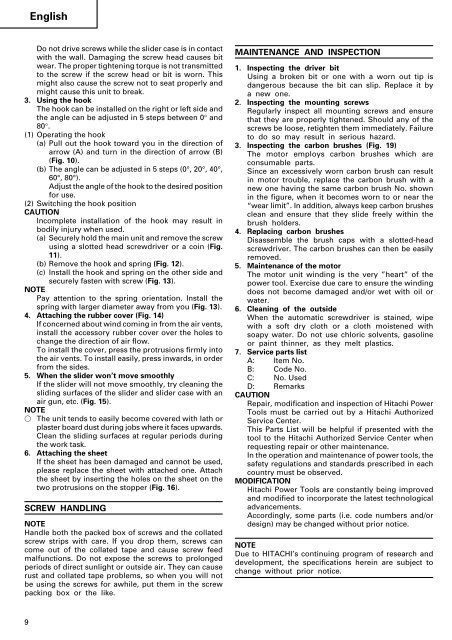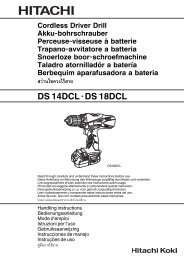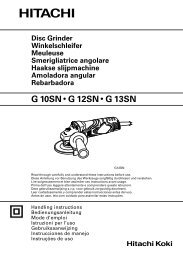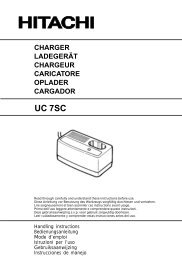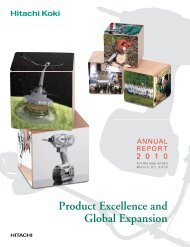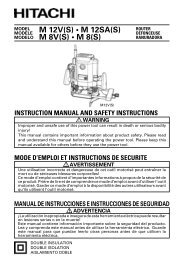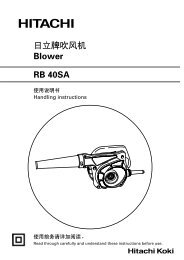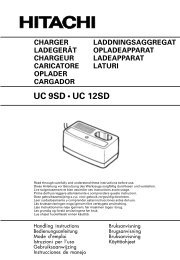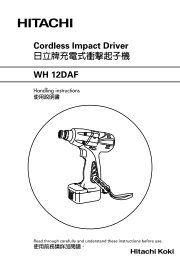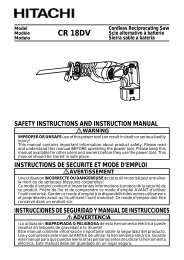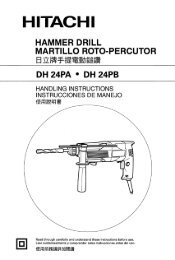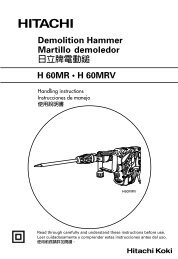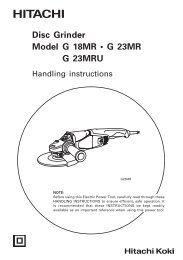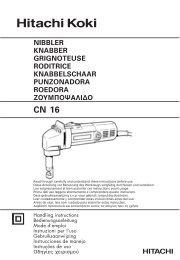e - Hitachi Koki Co., Ltd.
e - Hitachi Koki Co., Ltd.
e - Hitachi Koki Co., Ltd.
Create successful ePaper yourself
Turn your PDF publications into a flip-book with our unique Google optimized e-Paper software.
9<br />
English<br />
Do not drive screws while the slider case is in contact<br />
with the wall. Damaging the screw head causes bit<br />
wear. The proper tightening torque is not transmitted<br />
to the screw if the screw head or bit is worn. This<br />
might also cause the screw not to seat properly and<br />
might cause this unit to break.<br />
3. Using the hook<br />
The hook can be installed on the right or left side and<br />
the angle can be adjusted in 5 steps between 0° and<br />
80°.<br />
(1) Operating the hook<br />
(a) Pull out the hook toward you in the direction of<br />
arrow (A) and turn in the direction of arrow (B)<br />
(Fig. 10).<br />
(b) The angle can be adjusted in 5 steps (0°, 20°, 40°,<br />
60°, 80°).<br />
Adjust the angle of the hook to the desired position<br />
for use.<br />
(2) Switching the hook position<br />
CAUTION<br />
Incomplete installation of the hook may result in<br />
bodily injury when used.<br />
(a) Securely hold the main unit and remove the screw<br />
using a slotted head screwdriver or a coin (Fig.<br />
11).<br />
(b) Remove the hook and spring (Fig. 12).<br />
(c) Install the hook and spring on the other side and<br />
securely fasten with screw (Fig. 13).<br />
NOTE<br />
Pay attention to the spring orientation. Install the<br />
spring with larger diameter away from you (Fig. 13).<br />
4. Attaching the rubber cover (Fig. 14)<br />
If concerned about wind coming in from the air vents,<br />
install the accessory rubber cover over the holes to<br />
change the direction of air flow.<br />
To install the cover, press the protrusions firmly into<br />
the air vents. To install easily, press inwards, in order<br />
from the sides.<br />
5. When the slider won’t move smoothly<br />
If the slider will not move smoothly, try cleaning the<br />
sliding surfaces of the slider and slider case with an<br />
air gun, etc. (Fig. 15).<br />
NOTE<br />
The unit tends to easily become covered with lath or<br />
plaster board dust during jobs where it faces upwards.<br />
Clean the sliding surfaces at regular periods during<br />
the work task.<br />
6. Attaching the sheet<br />
If the sheet has been damaged and cannot be used,<br />
please replace the sheet with attached one. Attach<br />
the sheet by inserting the holes on the sheet on the<br />
two protrusions on the stopper (Fig. 16).<br />
SCREW HANDLING<br />
NOTE<br />
Handle both the packed box of screws and the collated<br />
screw strips with care. If you drop them, screws can<br />
come out of the collated tape and cause screw feed<br />
malfunctions. Do not expose the screws to prolonged<br />
periods of direct sunlight or outside air. They can cause<br />
rust and collated tape problems, so when you will not<br />
be using the screws for awhile, put them in the screw<br />
packing box or the like.<br />
MAINTENANCE AND INSPECTION<br />
1. Inspecting the driver bit<br />
Using a broken bit or one with a worn out tip is<br />
dangerous because the bit can slip. Replace it by<br />
a new one.<br />
2. Inspecting the mounting screws<br />
Regularly inspect all mounting screws and ensure<br />
that they are properly tightened. Should any of the<br />
screws be loose, retighten them immediately. Failure<br />
to do so may result in serious hazard.<br />
3. Inspecting the carbon brushes (Fig. 19)<br />
The motor employs carbon brushes which are<br />
consumable parts.<br />
Since an excessively worn carbon brush can result<br />
in motor trouble, replace the carbon brush with a<br />
new one having the same carbon brush No. shown<br />
in the figure, when it becomes worn to or near the<br />
“wear limit”. In addition, always keep carbon brushes<br />
clean and ensure that they slide freely within the<br />
brush holders.<br />
4. Replacing carbon brushes<br />
Disassemble the brush caps with a slotted-head<br />
screwdriver. The carbon brushes can then be easily<br />
removed.<br />
5. Maintenance of the motor<br />
The motor unit winding is the very ”heart” of the<br />
power tool. Exercise due care to ensure the winding<br />
does not become damaged and/or wet with oil or<br />
water.<br />
6. Cleaning of the outside<br />
When the automatic screwdriver is stained, wipe<br />
with a soft dry cloth or a cloth moistened with<br />
soapy water. Do not use chloric solvents, gasoline<br />
or paint thinner, as they melt plastics.<br />
7. Service parts list<br />
A: Item No.<br />
B: <strong>Co</strong>de No.<br />
C: No. Used<br />
D: Remarks<br />
CAUTION<br />
Repair, modification and inspection of <strong>Hitachi</strong> Power<br />
Tools must be carried out by a <strong>Hitachi</strong> Authorized<br />
Service Center.<br />
This Parts List will be helpful if presented with the<br />
tool to the <strong>Hitachi</strong> Authorized Service Center when<br />
requesting repair or other maintenance.<br />
In the operation and maintenance of power tools, the<br />
safety regulations and standards prescribed in each<br />
country must be observed.<br />
MODIFICATION<br />
<strong>Hitachi</strong> Power Tools are constantly being improved<br />
and modified to incorporate the latest technological<br />
advancements.<br />
Accordingly, some parts (i.e. code numbers and/or<br />
design) may be changed without prior notice.<br />
NOTE<br />
Due to HITACHI’s continuing program of research and<br />
development, the specifications herein are subject to<br />
change without prior notice.


